order Pregabalin online This afternoon I went with a friend to the swamp directly south of New Orleans, the Barataria Preserve, an arm of the “Lafitte National Historical Park and Preserve.” The Barataria area is a nature park, but its place in the larger historical context is interesting and I’ll note it briefly: Jean Lafitte (he has a nearby town named after him called “Gene Lafeet,” but the man himself is generally given the honor of Francophone pronunciation), was an 18th-19th century pirate who lived in the swamp south of New Orleans; during the War of 1812, he helped Andrew Jackson defend the city against the invading British (one of the few American victories during the war) and became a local hero.
Ksar Hellal The Preserve offers something of an idea of the landscape Lafitte lived in. It’s easy to see how he managed to carve out a buccaneer’s life within twenty miles of what was one of North America’s wealthiest cities. The swamp is nearly impenetrable: accessible only by flat-bottomed boats (in small parties), it extends without notable landmarks for dozens of miles, and was completely unmapped (and was in a certain sense unmappable). A few knowledgeable men could defend it nearly indefinitely, as the swamp provided food, water, timber, clothing (the Louisiana swamps were and still are the best furtrapping land in America), and cover. What is more, the swamp ultimately communicates directly with the Gulf, and Lafitte could intercept ships or smuggle goods past the Customs Houses of New Orleans.
This was my first visit. It had not been high on my list of things to do for several reasons. First of all, although it is part of the National Park system (which usually indicates something fairly remarkable), it does not have the name and draw of a place like the Everglades. Second, although I know swamps hold a tremendous amount of life, I’d be afraid the animals would be someplace far away and inaccessible, and I’d end up staring at some trees and duckweed and then go home.
The experience of Lafitte was completely different. It knocked my socks off. First of all, let’s start with the charismatic megafauna, which everyone knows are necessary for a satisfying nature experience (a grand view can obviate this necessity). Lafitte has alligators, those most amazing cousins of the dinosaurs. At first my fears of being far away from the interesting parts of the swamp was fulfilled: my friend and I walked the length of the boardwalk and didn’t see one (a great disappointment). But on our way back over the same route, we saw seven. They were moving a bit more, and our eyes were better.
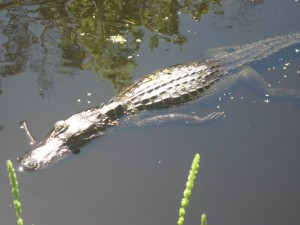 The beauty and horror of an alligator in its native environment can be barely be described. None of them felt threatening, but they were not timid the way most wild animals are: a small one, which posed no danger to us, swam up within eight feet of our toes on the boardwalk (which was only a few inches above the surface of the water and not at all protected): it was shocking that he was not afraid of us. He had the fearlessness of a creature at the top of the food chain. And the alligators were hungry, still recently awakened from their winter torpor. If you threw a stick into the water, they would swim right to it to investigate. One crunched the stick into bits just to make sure. They were astonishing to watch: long legs (surprisingly so), long powerful tails, huge webbed feet showing up clear in the pellucid yellow water, and those eyes of patient malice, or rather, perfect self-interest.
The beauty and horror of an alligator in its native environment can be barely be described. None of them felt threatening, but they were not timid the way most wild animals are: a small one, which posed no danger to us, swam up within eight feet of our toes on the boardwalk (which was only a few inches above the surface of the water and not at all protected): it was shocking that he was not afraid of us. He had the fearlessness of a creature at the top of the food chain. And the alligators were hungry, still recently awakened from their winter torpor. If you threw a stick into the water, they would swim right to it to investigate. One crunched the stick into bits just to make sure. They were astonishing to watch: long legs (surprisingly so), long powerful tails, huge webbed feet showing up clear in the pellucid yellow water, and those eyes of patient malice, or rather, perfect self-interest.
But that wasn’t all we saw: two rabbits (one heading right for an alligator on the shore for awhile, but he turned aside and averted his “Wild Planet” moment), garter snakes, several lizards, green tree frogs, bull frogs galore, birds to give the place the semblance of the bird house at the zoo (unsourced squawks and songs), two water moccasins (also fearless, and hence not pleasant to be around), water teeming with some kind of guppie-related mosquitofish, squirrels, diving beetles, garfish, the most beautiful dragonflies you can imagine, even a skink.
This was in the early afternoon, which is the least active time of day for animal life. I can hardly imagine what the place would be like at twilight – terrifying, most likely. And an evening swim would be courting almost certain death. This is a strange fact to consider: that certain behaviors, not harmful to any other thing, will cause other creatures to kill you, as dropping a stone will cause it to fall.
This was a gorgeous crisp spring day, all blue skies and dry air. The preserve must be less inviting during the heat of the summer – thankfully, there were almost no mosquitos today, though they have been in the air for weeks in the city – and during the winter, the alligators are not active. But in good conditions, this place is a must see when in New Orleans with a vehicle.
And the basis for all the animal life is the amazing swamp vegetation. The trail runs from hardwood forest on fairly solid ground – mostly oak, red maple, and sweet gum – through shallow swamp of cypress and sour gum (tupelo) – into open swamp grassland. I was far enough away from New York to see the Darwinian variations on the same basic stock of vegetation: to see strange swamp dogwoods and oaks, or the unusual local leaf-shape on the (annoyingly ubiquitous) poison ivy, or the fat butts on the tupelo trees. Some species look almost the same, and they astonish you even more: the red maple, a dominant species on Wildcat Mountain in the Catskills, can be found here growing in two feet of standing subtropical water, and looks pretty much the same. And of course, toss in the irises and waterlilies and all those lovely things.
Of course there were also the little quirks, like the crazy squirrel on the path, who has gotten a reputation on the preserve. He hangs around on the boardwalk, posing for pictures. He was not dying, as the picture might indicate. When I whipped out my camera he leaped onto the railing and splayed himself out as you see, as if to say, “Take a picture of me chillin’.” Naturally, we feared rabies and mange, and tried to give him a bit of space.
The swamp was accessed by boardwalks, which were generally in excellent condition. They were flooded at one point, and it was necessary to take off our shoes and walk through the water. Of course, I’m hoping I don’t get cholera from the crossing. I already checked for leeches.
All in all, a fantastic day with the spirit of Jean Lafitte in the life-loving swamps. But there is a back story to this. This is precisely the kind of “wetland” that Louisiana is losing, and the area around Lafitte is probably the single most affected wetland-loss area in America. All the area directly south of New Orleans is turning into ocean, which would make the city completely indefensible during hurricanes (a far more powerful adversary than the British, pace Lafitte and Jackson). Lafitte Preserve is predicted to have no more than fifty years of existence left, unless something is done to arrest the erosion there. Local sanitation departments dump Christmas trees in the swamps now, but my friend informed me, “Nothing human beings can do to truck in sediment can possibly save an area of this size from eroding. The only hope is an Army Corps diversionary project in order to bring river sediment here. Otherwise, this place is doomed.” He tells me the Corps is working on it, as they are now aware that New Orleans cannot be saved without the wetlands of Lafitte.
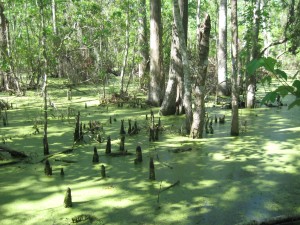
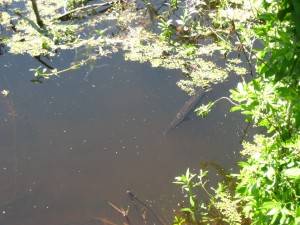
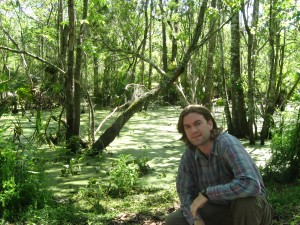
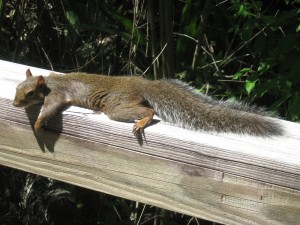
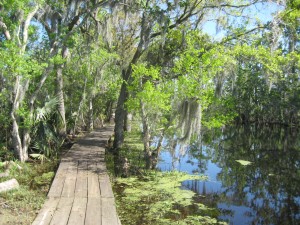
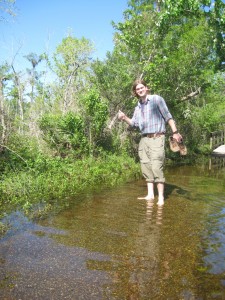
One Trackback/Pingback
[…] life, is one of the great things I have seen (another trip to a natural place nearby is narrated here). Its distance from the coast removes it from the cooling ocean breezes, so it is truly tropical […]
Post a Comment